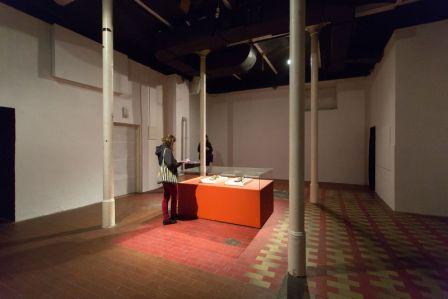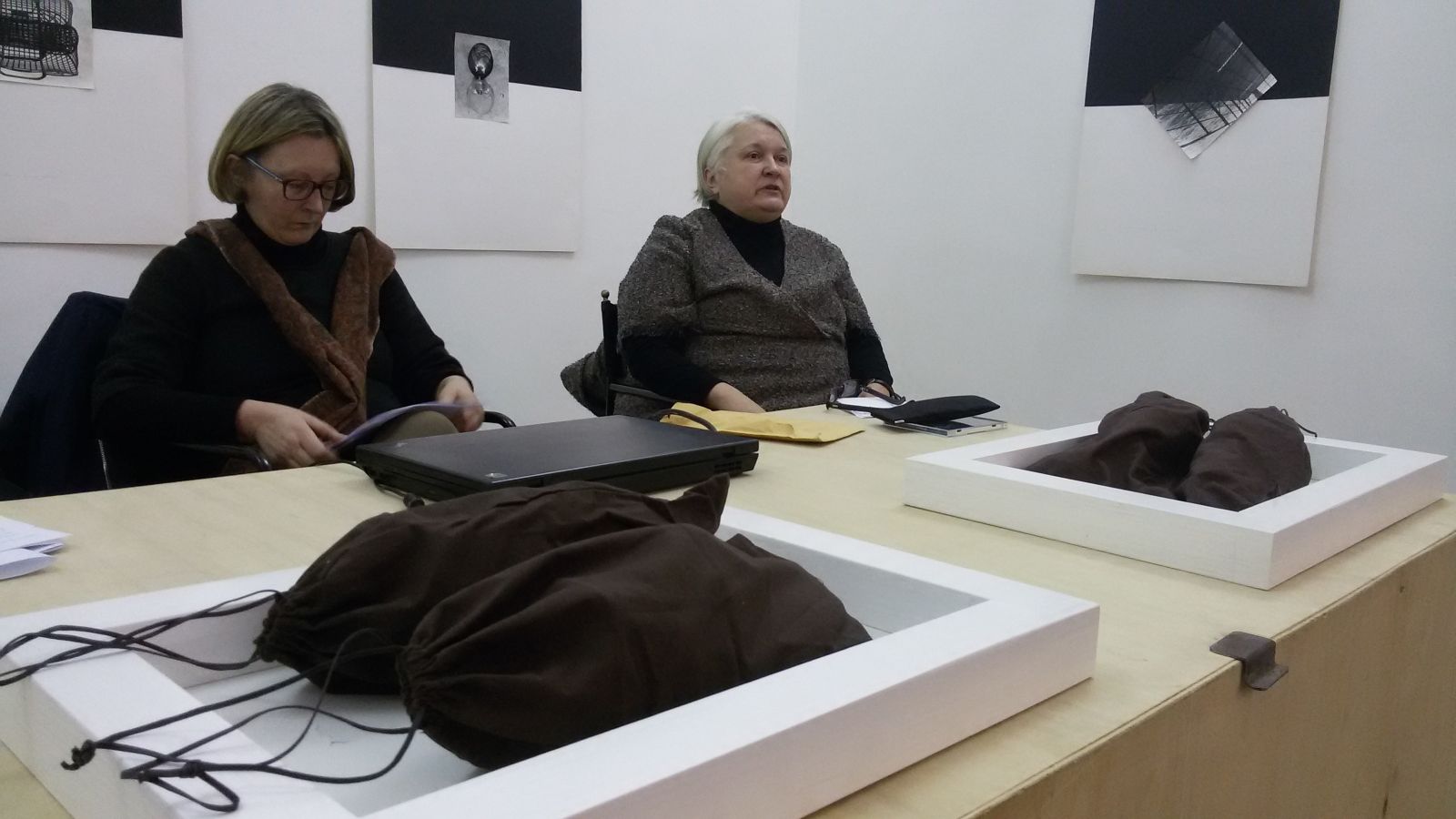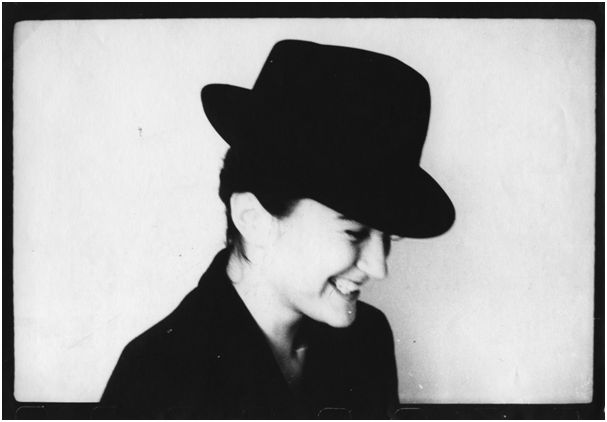aprilija lužar and lela b. njatin
in conversation with lilijana stepančič

Trieste, Studio Tommaseo (via del Monte 2/1)
Thursday, January 26, 2017, 6:30 pm
the event is supported by the Municipality of Kočevje
free admittance
+39 040 639187
info@triestecontemporanea.it
some notes from the introduction by Lilijana Stepančič
Lela B. Njatin and Aprilija Lužar were born in the same year (1963). They are both artistically active in Ljubljana and in a local small town in Slovenia called Kočevje. They do not have a gallerist nor the experiences of participating in the art market. Creatively they share a common interest of expressing themselves by exploring their own body. Nevertheless, of the similarities both artists share, they represent two different paths of contemporary visual art and two different positions in relation to the actual question of what the role of art in society is. Aprilija Lužar is an activist and an artist who is engaged in feminism and lesbian rights. Lela B. Njatin doesn't see her work as a feminist practice. However, she does not deny the existence of woman’s subjectivity, does not make woman generic and thus non-specific in relation to the subject’s positioning in art and within society.
In conversation with Lilijana Stepančič the artists will discuss their position in the recent art system in Slovenia. This is characterized by the dominance of public galleries with no or insufficient production resources, numerous non-government organizations that fulfil the individual interests of small closed groups of artists, and tiny private galleries active in the art market.
Aprilija Lužar and Lela B. Njatin have been active in the art world for more than three decades. Regardless of the fact that they share many common characteristics, they were first presented together only fairly recently and this at the exhibition with the title The Trails of Dematerialised Bodies as a part of the festival City of Women in 2015 in Ljubljana. The exhibition highlighted the general features that marks today's contemporary visual art, gave insights into the differences between the two artists, and created an artistic statement on the question what constructs a person today.
The exhibition contained two works. Aprilija Lužar exhibited a sound installation with the title Traveller 1001 x 1 Red Shoe A. The work is composed of the sounds of a woman walking that is every so often interrupted by the voice of a woman in her encounters with other women. The second work at the exhibition was the ready-made diptych titled The Promise of Truth. The Portrait of a Mother and The Path of All Living. Self-Portrait made by Lela B. Njatin. It is an exhibition case covered by glass that shows two pairs of worn, rather similar women shoes. Both works portrait a woman walking, avoid the physicality of the body, and do not show the directions of movement. Both also picture complex relations, roles, and positions women hold as individuals and in society as a whole.
What we have seen and heard at the exhibition invited further questions: Who are the women that are only present as traces left in the shoeprints or in the echo of a shoe striking the floor? Where and why have they gone, walked, ran? What have they seen and experienced? What was, or is, their position and role in society? Has their gender specifically influenced their lives? The exhibition tried to give answers to those questions through the form of genre of portrait and self-portrait.
The sound installation is composed by concrete voices and words: the strikes of shoe on the floor when a body moves and elementary and culturally based speech. They fill the gallery space with repetitiveness and rhythm. The work is a contemporary sound piece that can be placed between experimental compositions and immaterial sound installations. What is particularly exciting about it is the minimal use of elements that went into its composition.
The sounds of a woman walking were recorded between 2005 and 2007, but mainly in 2006 in the building on the Ulica Kralja Držislava 2 in Zagreb, where the offices of ROSA (Centre for the Women Victims of War), the Women Support Centre and the Kontra – Lesbian Group were located. Other recordings were made in Ljubljana, Dolnja Briga near Kočevje, and New York. The infinite wavy sea of the sounds of walking are interrupted by the curse of a veteran feminist activist who says: ”Fucking hell. Another kick in the teeth,” and by a brief introduction between the feminist Nela Pamuković who opens the door and says: “Nela,” and the artist who replies: “Aprilija”. Although the sounds are recorded in actual and known places, the work has anything but a documentary character to it. Instead, it is generic, abstract, and marked by temporal non-specificity. The audience doesn't know where the woman is headed, where she is and who she is talking to.
The work presents a story about a woman and her embeddedness in the environment. Indeed, for many years it is precisely such an embeddness that has been the focus of Aprilija Lužar in her activity within feminist art practices even though the sounds of a woman walking are a portrait of Aprilija Lužar and a feminist community. The walking is trapped in a snare, it rigidly resonates against the floor, the echoes are unstoppable. All these instances symbolically speak about a woman who is hurt and moved to the margins of society. She has to struggle for her rights.
The ready-made diptych was submitted in the waves of sound that fill the gallery space. A duo of similar, but not identical, pairs of shoes are placed on a table in the middle of a low-edged wooden rectangular tray, an allusion to the actual urban rectangular fountain with the modernist sculpture Girl with the whistle by Stane Jarm from 1963 that is located on the square in front of the block of flats in Kočevje where Lela B. Njatin and her mother lived. These completely ordinary pairs of shoes, placed in two wooden frames, cannot be touched. They are covered by the gallery’s glass case. The installation reminds us of the Duchamp’s approach: “In art, the representation of reality is an attempt to dig deeper into the essence of this reality. Such an attempt is a promise that art will deliver truth about the world. This is not my authentic personal belief but has to do with the culture I’m born into. This body of work isn’t a reflection on that belief; I simply take it as a common cognitive frame which attunes me with the rest of the field of art.”
Therefore, the diptych is a narrative of the personal biography of the artist and her mother which is personified by two pair of shoes, one of her, and one of mother’s. Both pairs are similar, comfortable, and suitable for walking. They symbolically and actually represent a long sojourn and a complex relationship between a mother and a daughter. The work illustrates the differences as well as similarities about both persons with regards to their biological role, generation, and cultural formation. It points to the physical, psychological, and cultural bonds between a mother and a daughter.
Both works are the contemporary version of portraits and self-portraits. As such they do not picture concrete faces, breasts, arms, personal belongings, and the social context of a given individual person or a group of people as are the norms in classical portraits. A move away from the characteristics of the classic genre of portrait art that is seen it both works is directed towards anti-portraits and anti-self-portraits. All this means that the works deny the previous construction of overall meaning of person. This is why the works do not speak about the actual direction of movement of the persons and miss the body as such. Instead, they use for the formation of a person just the traces of their lives; traces left on the objects they used and in the relations they created. Thus they construct dematerialised and absent bodies. The artists want to tell us that the representation of a person today is constructed by intensive sensorial and emotional recollections that the traces of lives awaken in others.
The anti-portraits and anti-self-portraits transform personal construction into relations. In this way actual bodies disappear. What is corporeal becomes immaterial; as such it interrogates transformations and relationships. That is why there are only shoes and the sounds of walking on display not bodies. Namely, the trails of dematerialised bodies excavate from the real/material world more profound insights into art and into human existence, too.

Aprilija Lužar is a socially engaged feminist artist whose works tackle violence against women, the position of women in society, and lesbian activism. She completed the Academy of Fine Arts in Sarajevo and in Ljubljana. She makes paintings, performances, sound works, participatory projects, and installations.
Lela B. Njatin is a publicist, writer and visual artists. She completed the Faculty of Arts in Ljubljana. Between 1975 and 1985 she was a member of the art collectives of conceptual and mail art Westeast, Maj 75 and Signalizam. Since 2010 she has made interdisciplinary installations, performances, participatory projects, and anti-monuments.
Lilijana Stepančič is art historian, sociologist and economist. She was a director of International Centre of Graphic Arts, Open Society Institute-Slovenia and Soros Centre for Contemporary Arts-Ljubljana. She was a member of the National Board for Culture of the Republic of Slovenia and a founding member of Manifesta.
supported by

